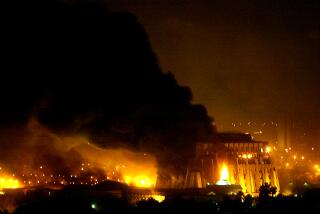Afghan commander Massoud, killed on eve of 9/11 attacks, is a national hero
- Share via
Reporting from Kabul, Afghanistan — Before there was 9/11 in America, there was 9/9 in Afghanistan.
On the eve of the attacks on New York and the Pentagon, assassins working for Osama bin Laden murdered Ahmed Shah Massoud, military commander of the anti- Taliban force known as the Northern Alliance.
American intelligence officials say Bin Laden acted preemptively to eliminate a natural ally of the U.S. if Washington were to invade Afghanistan to topple the Taliban regime that had sheltered Bin Laden and his Al Qaeda followers.
In death, Massoud has been turned into a ubiquitous national symbol by the Afghan government, with the encouragement and support of America.
President Hamid Karzai, soon after taking office, proclaimed Sept. 9 as Massoud Day. Commemorative ceremonies are held each year at Afghan military bases and at the domed mausoleum overlooking the verdant Panjshir Valley north of Kabul that houses Massoud’s tomb.
In Kabul, the capital, Massoud’s picture is displayed in the national stadium, and the traffic roundabout near the compound that includes the U.S. Embassy is named for him.
Banners on busy streets of Kabul read, “Unity is Massoud.”
It’s all quite a turnaround for the image of the onetime engineering student who helped lead the guerrilla movement that ousted the Soviets, served in the post-Soviet government but then wound up a loser when the Taliban eventually took over.
At the time of his death at age 48, Massoud had retreated to the Panjshir Valley and was cutting deals with Tehran and Moscow in hopes of continuing his fight against the fundamentalist Muslim movement. He was killed by Al Qaeda agents posing as television journalists conducting an interview.
Many Afghans now say their proudest moment was fighting beside Massoud.
Cabdrivers, farmers, shopkeepers and provincial officials will gladly tell reporters about their relationship with Massoud, a former Kabul University student who learned the tactics of Mao Tse-tung and Che Guevara in developing a strategy to fight the Russian occupation forces.
“Massoud and I were close,” said Afghan army Sgt. Maj. Barakatullah Kolistani, a leader at the NATO-run army training camp in Kabul. “Once I was surrounded by enemy and he sent a message, ‘I will rescue you because I need you. Together we will fight.’”
In the village of Nawa in Helmand province, the district governor, Haji Abdul Manaf, talks joyfully of following Massoud’s orders to ambush Soviet troops, including sending explosives-laden donkeys into their bivouacs at night.
“Massoud knew how to fight; we all followed him,” he said.
In his book, “Afghanistan: A Military History from Alexander the Great to the War Against the Taliban,” Stephen Tanner notes that Massoud not only was brave, but he was one of the few resistance leaders to use modern tactics: “dividing his men between aggressive strike forces, troops committed to stationary defense and mobile reserves.”
Massoud also insisted on unit discipline, trained his men in advanced weaponry and tried to install civilian rule in areas he controlled, writes Tanner, whose book has a picture of a wistful Massoud, clutching an AK-47, on the cover.
A fuller story contains mixed elements.
Like so much else in Afghanistan, the lionizing of Massoud breaks down along ethnic lines. Among Pashtuns, the largest ethnic group (and the one from which the Taliban movement is largely drawn), Massoud, a Tajik, is far from a revered figure; indeed, many Pashtuns recall him with outright loathing.
The cult of Massoud is also a frequent source of tension in the ethnically fractured ranks of the Afghan security forces. That is particularly true in the south, where Tajik soldiers and police officers wind up dealing with a mainly Pashtun population that regards them as being nearly as alien as the Western forces in their midst.
Questions remain, as well, about civilian casualties inflicted by his troops and deals he made, including with the Soviets, during the decade-long occupation.
During the fight against the Soviets, the CIA provided only minimal assistance to Massoud, preferring instead to back a resistance leader favored by Pakistani intelligence officials, a fellow Pashtun. Massoud was deeply suspicious of the Pakistanis and their sympathy for the Taliban and Bin Laden.
Although Karzai has paid tribute to Massoud, the president’s bitter rival, Abdullah Abdullah, attempted to position himself as Massoud’s rightful heir during the disputed election last year. A close advisor of Massoud, Abdullah compared Massoud’s reputation for personal incorruptibility with Karzai’s more mixed history.
The U.S. has encouraged the elevation of Massoud to national hero status in hopes that his memory will serve as a rallying cry against the resurgent Taliban.
At a dedication ceremony in 2007 at the Massoud mausoleum, a Marine Corps general, James N. Mattis, told the hushed gathering that thinking of Massoud gave him “some of the same emotions I felt when I visited the grave of George Washington, the father of our country.”
(At the time, Mattis was commander of the 1st Marine Expeditionary Force. He was recently named commander of U.S. Central Command, with responsibility for Afghanistan and Iraq.)
The Panjshir Valley has a Brigadoon-ish quality. Accessible through a tight mountain pass, the valley opens up with terraced fields, a stream and tidy homes. The Soviets launched multiple air-and-land assaults on the valley, only to be repulsed by Massoud’s troops.
Last week, Afghan military leaders and U.S. civilian and military officials gathered to lay a wreath at the mausoleum and celebrate the memory of the man known as the “Lion of Panjshir.”
“Massoud was a soldier’s soldier,” said Army Lt. Col. James Briggs, commander of the Panjshir Provincial Reconstruction Team. “It was an honor to march alongside our Afghan military brothers during the remembrance ceremony. We were marching as one, in unison, in honor of Massoud.”
tony.perry@latimes.com
Times staff writer Laura King in Kabul contributed to this report.
More to Read
Sign up for Essential California
The most important California stories and recommendations in your inbox every morning.
You may occasionally receive promotional content from the Los Angeles Times.













